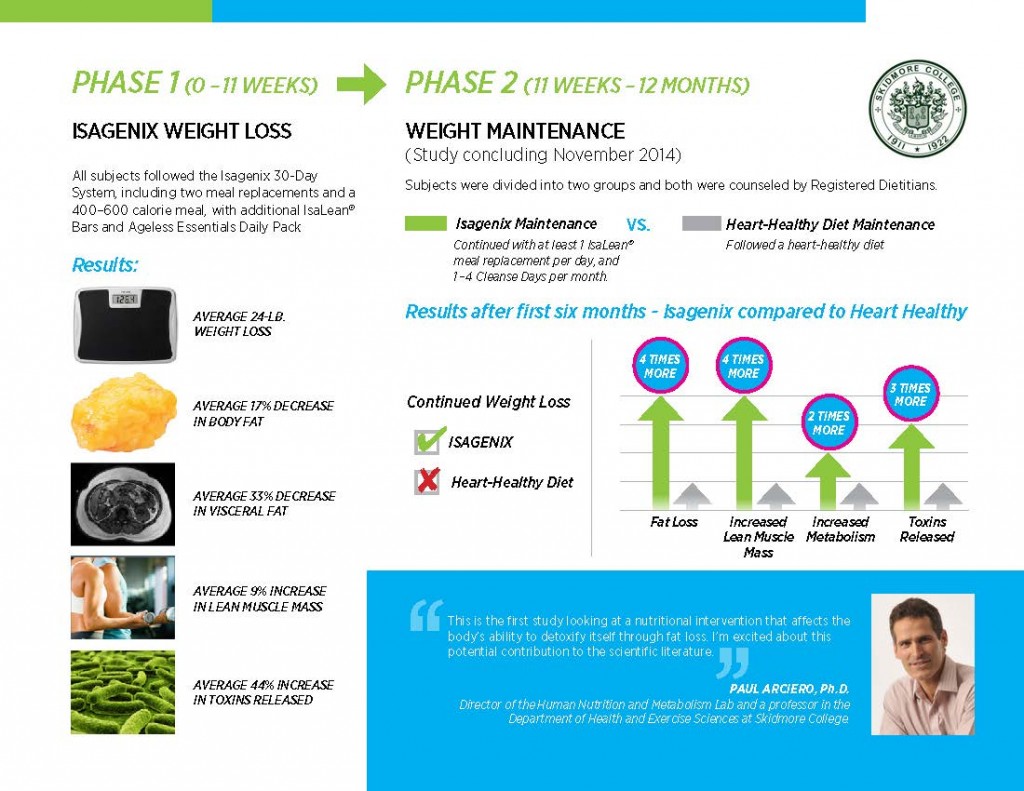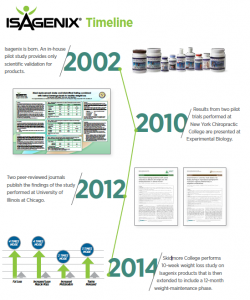The Science Behind the Isagenix 30-Day System

Scientific evidence continues to grow stronger of Isagenix products effectiveness for long-term weight loss.
Rewind back to 2002, and Isagenix was born out of an idea—call it a stroke of inspiration or a practical, thoughtful approach to a nutritional program—to produce a line of products like no other.
An important distinction was that these products would be combined into a system involving “Shake Days” and “Cleanse Days.” The Shake Days replaced two meals a day with shakes, allowing for flexibility on a third meal. The Cleanse Days, conversely, were one or two days a week of fasting supplemented by the herbal drink, Cleanse for Life, andIsagenix Snacks™ wafers.
It was this Isagenix 30-Day Cleansing and Fat Burning system (along with additional supportive products like Natural Accelerator, IsaFlush, and the adaptogenic-drink Ionix Supreme) that propelled the company to new heights in bringing convenient health and weight management to thousands of people.
Fast forward 12 years, and it’s easy to see that the different Isagenix product solutions have come a long way. Not only that, but the science behind Isagenix has come a long way as well. Seeking scientific validation of its core system, the company has now funded several independent clinical studies performed at colleges and universities.
Clinicians including Dennis Harper, DO, and Robert Watine, M.D., are credited with putting Isagenix on the path to clinical research by collecting data on their own patients using the products.
Beginning in 2009 at New York Chiropractic College, “proof of concept” of the Isagenix system began with two independent open-labeled pilot trials. The principal investigator, Mary Balliet, Ph.D., submitted her research to the renowned scientific conference Experimental Biology. It would be the first time that the system would strike interest within the scientific community, paving the way for further interest and research.
By the time 2010 and 2011 rolled around, the company had sought out collaborations with several colleges and universities for a variety of research studies. It was also in 2011 that Isagenix partnered with University of Illinois at Chicago (UIC), a leading research institution in the field of health sciences, health promotion, and disease prevention.
The UIC partnership would prove to be particularly fruitful, largely because of the selection of Krista Varady, Ph.D. as lead investigator. Dr. Varady’s previous research offered encouraging results from intermittent fasting regimens for weight loss and cardiovascular health.
Unlike other regimens, however, the Isagenix system was the first to incorporate both an intermittent fasting (Cleanse Days) and a calorie-restricted regimen together (Shake Days). Dr. Varady noted that she was excited at the prospect of comparing the system to a heart-healthy diet, the gold-standard benchmark.
Sure enough, after a 10-week study, subjects on the Isagenix system turned out to have superior results across all clinical parameters in comparison to the heart-healthy group. Notably, they lost more weight, more total body fat, and twice as much visceral fat leading to greater improvement in cardiovascular risk factors (2,3).
The UIC study was a major milestone for Isagenix. Its findings were reported in two reputable peer-reviewed journals in 2012, Nutrition Journal and Nutrition and Metabolism (2,3). In addition, in 2013 the study won the award for best poster in the Obesity Research Interest Section at the Experimental Biology conference.
It should have been no surprise that the results of the UIC study would attract other researchers who had an interest in evaluating Isagenix products. The company, however, was interested in taking research a step further—a new challenge for the Isagenix system. “Most companies would stop there, but not Isagenix,” said Chief Science Officer Suk Cho, Ph.D. “The question was whether people could maintain their weight loss. We also wanted to evaluate the detoxification component of the system.”
In collaboration with a new principal investigator, Paul Arciero, Ph.D., at Skidmore College, and toxicologist Don Patterson at AXYS Analytical Services, it was time to build on where prior research had left off. A new study was designed that would evaluate the system on both women and men, how it would affect arterial flexibility and blood flow (both markers of cardiovascular health), as well as its impact on basal metabolism.
The study was also the first to evaluate a “cleansing” factor by measuring the increase in circulating toxins as a result of the Isagenix system—the essential first step in detoxifying and eliminating harmful compounds from the body. It would be the first study of its kind to evaluate the influence of nutritional intervention on an increase in circulating toxins as a result of the weight loss achieved by a combination of “Cleanse Days” and “Shake Days.”
After an initial 10 weeks, the Isagenix system proved once again to deliver results consistent with the UIC study. The findings were presented as a poster at Experimental Biology and as an abstract in The FASEB Journal (4).
 At this point, Isagenix gave Dr. Arciero the funding to extend the study with a 12-month weight maintenance period. The initial subjects were split into two groups, with half assigned to a dietitian-counseled, heart-healthy diet and the other half continuing on a maintenance program using Isagenix products.
At this point, Isagenix gave Dr. Arciero the funding to extend the study with a 12-month weight maintenance period. The initial subjects were split into two groups, with half assigned to a dietitian-counseled, heart-healthy diet and the other half continuing on a maintenance program using Isagenix products.
After six months, the preliminary results were exciting for Isagenix. The system was still showing promising results with considerable metabolic and cardiovascular improvements, along with weight loss and metabolic rate maintained or improved. Currently underway is a review of the final data of the Skidmore College study after 12 months of weight maintenance.
Dr. Cho notes that few companies that market nutritional products ever venture into funding quality research to demonstrate the efficacy of their products. “We did. We want to show that using our products in the long-term leads to lasting benefits,” says Dr. Cho.
For customers who’ve enjoyed the system from its early years, it should come as little surprise that Isagenix products have worked so well. www.fatbgone.org #scienceofweightloss

Article originally printed in our “Why Diets Fail” Winter Science Newsletter.








